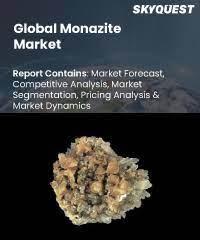Global Monazite Market Insights
Global Monazite Market size was valued at USD 53.38 million in 2021 and is poised to grow from USD 54.61 million in 2022 to USD 65.5 million by 2030, growing at a CAGR of 2.3% in the forecast period (2023-2030).
Monazite is a rare-earth element-containing phosphate mineral that is primarily reddish-brown in colour. Due to variability in composition, monazite is considered a group of minerals.It is frequently found in placer deposits. Monazite sands are found in significant quantities in South Africa, Madagascar, and India. Monazite deposits are abundant in India. Monazite is radioactive due to the presence of thorium and uranium.
The increasing demand for rare earth elements, growth in nuclear power generation, and the availability of monazite in abundance are some of the key factors driving the growth of the global monazite market. Moreover, the rising demand for REEs in electronics and medical applications, as well as the increasing use of thorium in nuclear fuel, are propelling the growth of the monazite market. However, the high cost of monazite extraction and environmental concerns related to thorium mining are likely to restrain the growth of the global monazite market. Furthermore, the stringent government regulations regarding the mining and processing of monazite and the presence of low-grade sources of monazite are some of the factors hampering the growth of the global monazite market.
Global Monazite Market Segmental Analysis
Global monazite market is segmented on the basis of type, application and region. On the basis of type, global monazite market is segmented into, alkaline cracking and acid cracking. On the basis of application, global monazite market is segmented into chemical, metallurgy, electronic and medical. On the basis of region, global monazite market is divided into North America, Europe, Asia Pacific, Latin America, and MEA.
Monazite Market Analysis by Type
On the basis of type, global monazite market is segmented into, alkaline cracking and acid cracking. The acid cracking segment holds the largest segment in terms of revenue shares in 2022. Monazite was initially heated in strong sulphuric acid to temperatures between 120 and 150 °C (250 and 300 °F) for several hours in order to break it and release the thorium and lanthanide components. Different techniques were used to separate thorium from the lanthanides depending on the acid-to-ore ratio. The use of acid techniques produced a significant amount of acid waste and reduced the phosphate content of the ore.
The alkaline cracking segment grows at significant CAGR during forecast period 2022 to 2028. A more recent process uses a hot sodium hydroxide solution (73%) at about 140 °C (280 °F). With the use of this procedure, the ore's precious phosphate content can be extracted and converted into crystalline trisodium phosphate. Hydrochloric acid can be used to dissolve the less basic thorium hydroxide and produce a solution of lanthanide chlorides from the mixture of lanthanide and lanthanide hydroxide. The extraction of rare-earth metals from monazite ore begins with digestion with sulfuric acid followed by aqueous extraction. The process requires many neutralization and filtrations.
Monazite Market Analysis by Application
On the basis of application, global monazite market is segmented into chemical, metallurgy, electronic and medical. The chemical segment accounted for the largest market share in the year 2022 and is expected to dominate throughout the analysis period. Monazite is an important source of thorium, cerium, and other rare elements. It is frequently mined as a by-product of deposits of heavy minerals. Sand made of monazite is used in building and casting.


